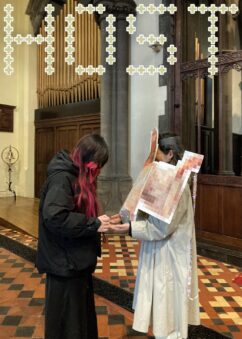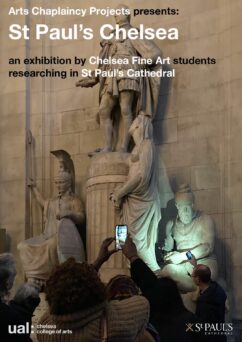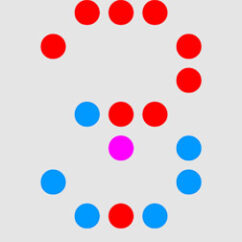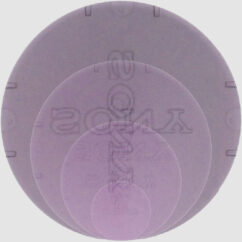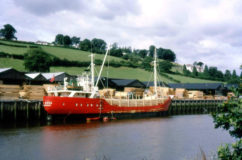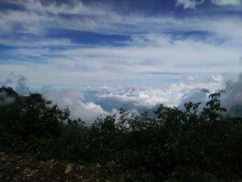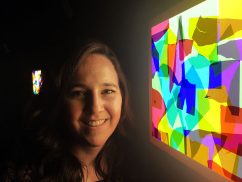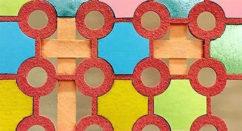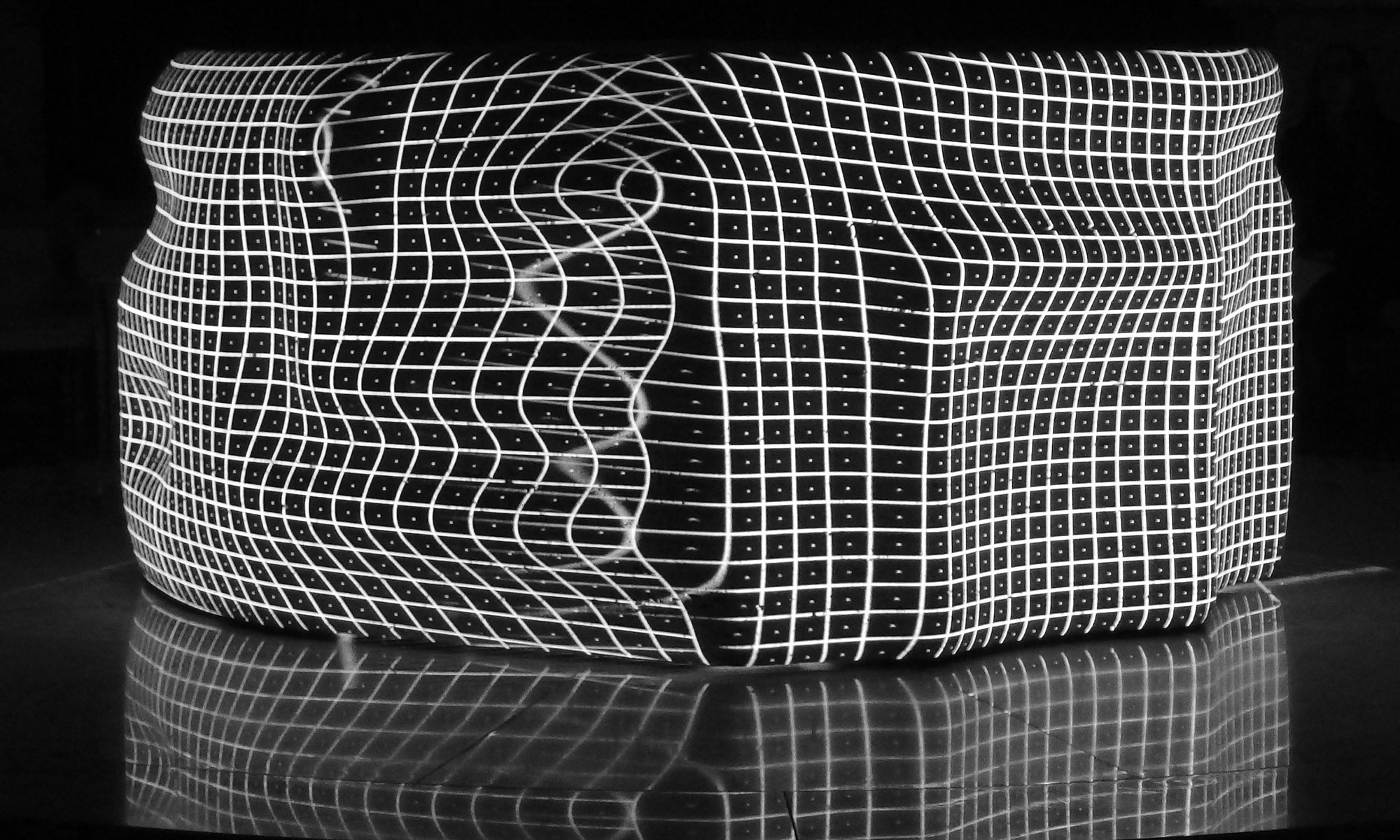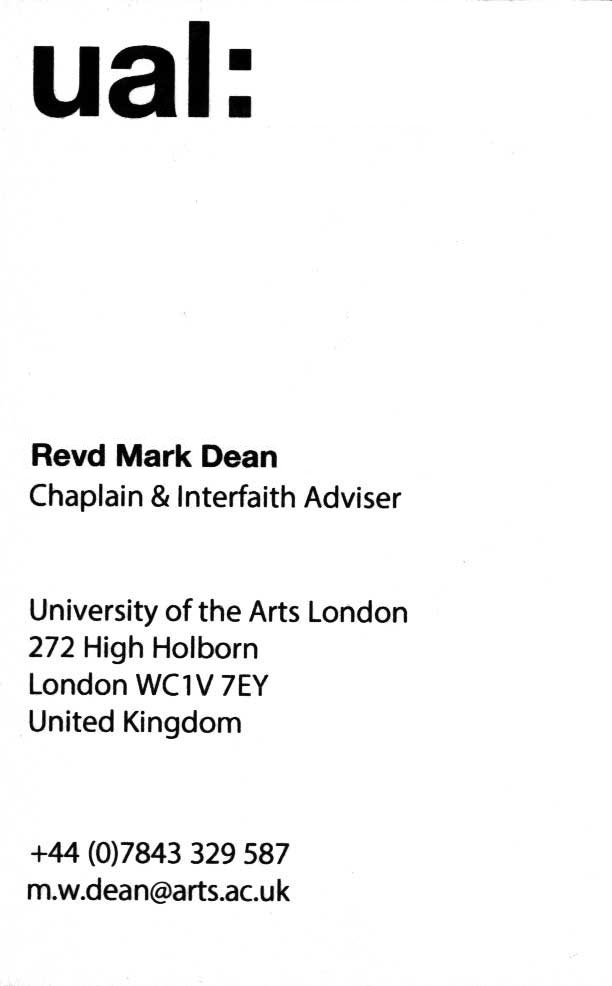Host 2024

25 February – 10 March 2024
St Saviour’s Church
St George’s Square
London SW1V 3QW
The fourth exhibition at St Saviour’s Pimlico by Chelsea MA Fine Art students alongside artists from the church, in partnership with Fr Matthew Catterick and course leader Ian Monroe.

1. Holly Jones
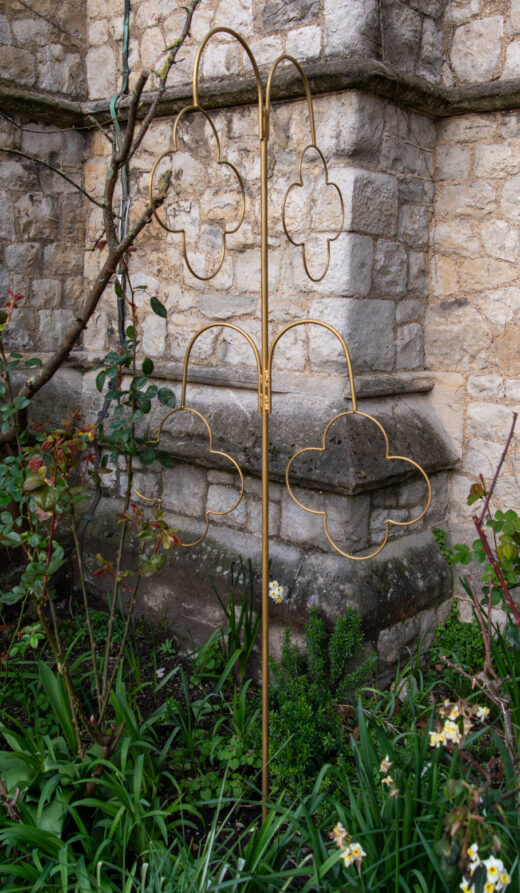
‘Metamorphosis’
steel and spray paint, 198 x 87 cm, 2024
The sculpture is situated outside the church entrance and takes influence from the shapes found within the church’s architecture. The stained glass windows from St. Saviours inspired the shapes seen within the metal structure. The sculpture aims to incorporate the natural elements of the garden from where it sits, making it feel like part of the greenery.
2. Wies Roeterdink
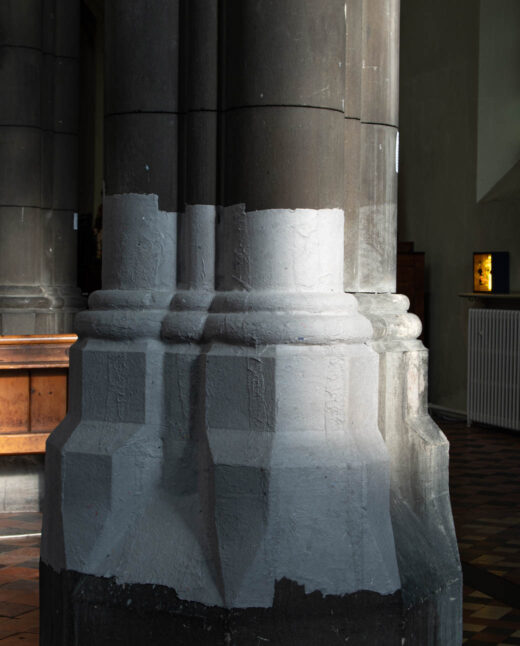
‘Adherence to a Column’
cast paper pulp, dimensions variable, 2024
The paper cast of the column becomes a pseudo-palimpsest, bearing marks that point towards different times, alterations, and interventions, while simultaneously pointing inwards, alluding to the sculpture’s own making. Casting compresses the many layers of the original structure’s history into a single, short-lived representation. As such, the work requires a nuanced negotiation of time; my conscious choice to use a non-durable material, paper, evidences the passage of time as it is inevitably vulnerable to change. This process mimes the natural processes that transform real buildings into ruins.
wiesroeterdink.cargo.site
@wies.art
3. Ruochen Dai

‘Prayer’
plaster, resin, 30 x 18 x 18 cm, 2024
People are constantly searching for new beliefs for their spiritual needs. From horoscopes, to MBTI-16 personalities (Myers-Briggs Type Indicator) derived from the concept of Jungian analysis and simplified to eight letters. They divided the complexity of human nature into 16 categories so has to find their own kind. People use these as a basis for defining themselves, and an over-reliance on these concepts labels, flattens and homogenises human beings.
4. Arianna Ruggiero

‘Twice Shy’
fabric, paint, felt, wood, 40 x 28 cm, 2024
The textile sculpture hangs alongside the kneeling cushions, using the same format to discuss the disconnect of feeling unable to pray. The pillow shaped sculpture is unable to be used to complete the act of prayer, as you would fall through the sculpture breaking it. Inspired by the poem ‘two headed calf’ by Laura Gilpin, the poem reminds us to look at the good while acknowledging the future might not be. The iconography replicated with the two headed lamb of god, referencing the displacement in trying to find comfort but unable to within the church. As the text on the sculpture references the feeling of needing to achieve perfection in order to be ‘worthy enough’ and rather the idea that anything falling short would equate to a sinner.
5. Julia Kaminska
‘Mt. 7: 7-8’
moving image, 2024
Mt. 7: 7-8 is an interpretation of experiences not my own, through the guidance of parishioners at St Saviours church in London, Pimlico. I have created an anonymous questionnaire asking the church attendees to share any mediums that fills them with divine inspiration. The answers ranged from pieces of literature, sculptures, architecture, to natural phenomena and more mundane experiences; using the answers provided I created a short video exploring a spiritual journey.
6. Yasmin Ghandour
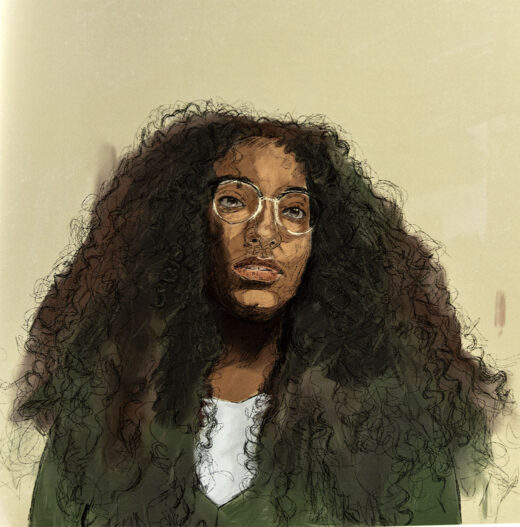
‘Agony in the Garden’
book of drawings, 21 x 27, 2024
The first station of the cross, The agony in the Garden of Gethsemane, is an episode in the life of Jesus, which occurred after the Last Supper and before his betrayal and arrest, all part of the Passion of Jesus leading to his crucifixion and death. It is here that he experiences distress and prays to be delivered from his impending suffering, while also accepting God’s will. I became drawn to this idea of praying to be spared misery but also accepting your fate. And that sorrowfulness occurs simultaneously with acceptance. I created drawings, trying to capture that duality in a way that I think represents everyday life — stillness, docile, distant but also hopeful.
yasminashley.com
@yasminashleyart
7. Gracie Schylling
‘Quietude’
LED light panel, wood, paper, wire, glass beads, 31 x 31 x 14 cm, 2024
Quietude is a light-box intended to invite the viewer in for a moment of contemplation. Inspired by the colours in the stained glass of St. Saviours and its pulpit, the box captures and preserves the quiet, calm feeling that can wash over you when you sit in a church. Regardless of the beliefs you hold or the religion you follow, there is something undeniable about the way we can be so affected by the play of light through stained glass. This type of light elevates us from our day to day lives and reminds us of the greater picture of life. It brings us to a place where we can begin to comprehend a reality beyond humanity – something intangible, something significant.
8. Arielle Clay

‘Fallen Sighs’ & ‘Lost Fragments’
wood, oil paints, silk and drawing paper, staples, fabric, 151 x 31 cm, 2024
Responding to the whispers of St. Saviour’s, Pimlico, by bringing together (visually) fragments and glimpses of an exchange between 3 forms of existence:
A church / holy building
The divine / sacred
Its visitors / human beings
9. Julia Hashem
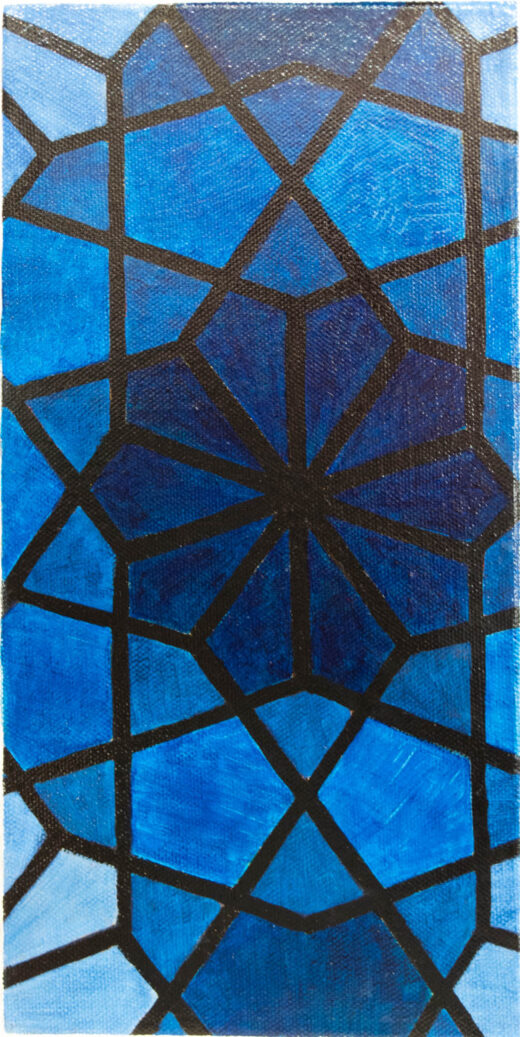
‘Uncommisioned Window’
acrylic, canvas, varnish, 15 x 30 cm, 2024
At this un-commissioned window, stand in contemplation, find all the similarities in our beliefs, you might find many points of convergence. A piece inspired by the stained glass of the church, I share a piece of myself, and listen as the church shares something of itself with me in every window and every wall.
10. Henry Dawnay
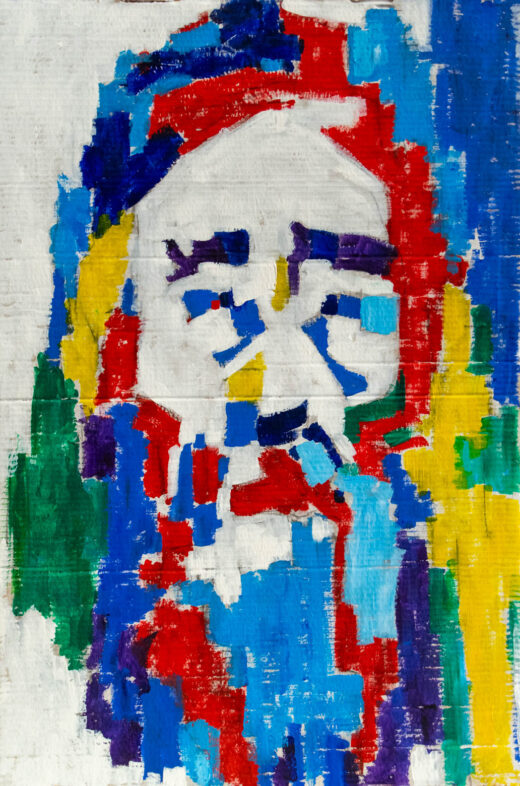
‘Turin Shroud (shrouded in mystery)’
acrylic on cardboard , 61 x 91 cm, 2024
This was work was inspired by the Turin Shroud, the legendary cloth in which Jesus was wrapped after his crucifixion. The bright colours are inspired by a sense of the resurrection – Jesus’ return to life. The reason why cardboard is used is that cardboard is everywhere – as the Kingdom of Heaven is all around us.
Henry Dawnay studied Classical Realism for four years in Florence, Italy. He is a local resident and member of St Saviour’s congregation. He is available for commissions.
henrydawnay.com
@henry_dawnay_gallery
11. Sookyung Kim
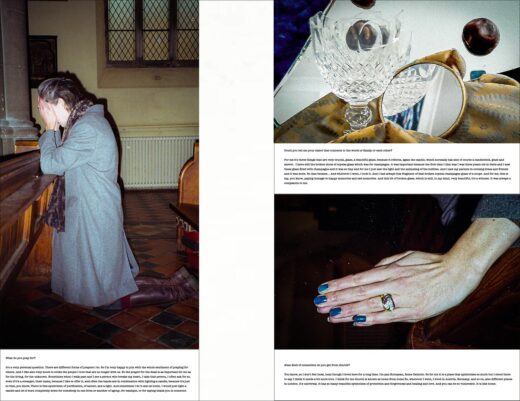
‘Many people’s faith is embedded in the way they live their lives’
coated paper mounted onto foam board, 43 x 29 cm, 2024
Despite differences in religious experiences and beliefs, a church is a space where individuals find diverse values for various reasons. It can offer peace and tranquility to people and sometimes serve as a place for reflection, repentance, and self-reflection. The church, as a space, feels like a ‘hall of communication’. One sees prayer as an act that provides such experiences and connects the world. Kneeling and praying transcend cultural and religious boundaries. Through this act of kneeling, we become connected to societal, political, or inner human struggles.
kimsookyung.cargo.site
@keemsooyaa
12. Abbie Coombs

‘Unexpected Visitor’
law school graduation/lawyer’s robe, sonogram, St Paul’s Cathedral vestment stand, thread, 160 x 60 x 30 cm, 2024
How do you mourn the loss of someone/something, when that loss is the result of an active choice? The element of choice does not make the weight of the interlaced grief any less heavy to bear. Where is the space in society where I can grieve that loss, proudly? When the only memory exists in a sonogram, I’d like to immortalise it. Churches provide a space of solace for many. I hope this installation and performance inspires those who have experienced the loss of an unborn child, whether that loss was a choice or not, to mourn properly. Loss and grief are universal human emotions. In times of deep suffering, it is empathy and unity through the medicinal power of talking, not polarisation, which has the power to heal.
13. Oria Xu
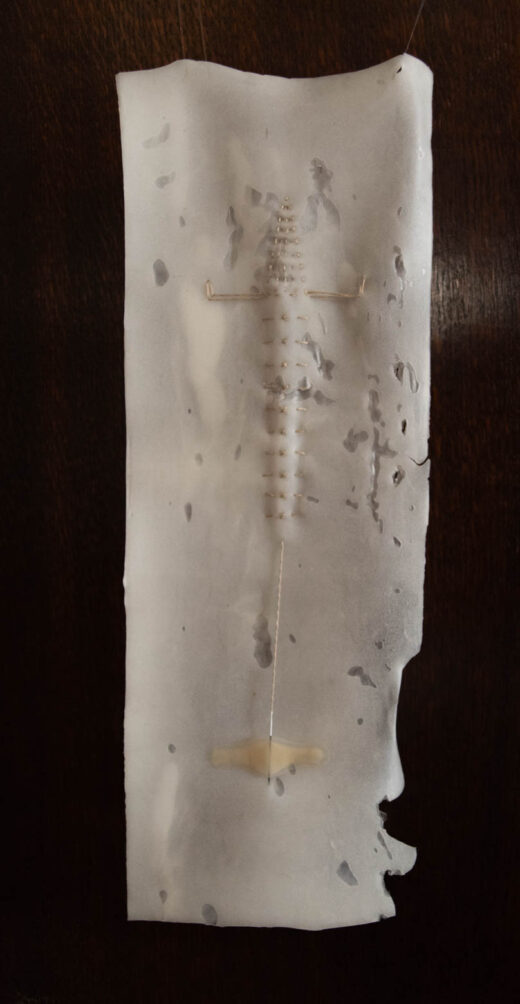
‘Untitled’
Silicone, needle, cotton wires, band-aid, 40 x 15 cm, 2024
The combination of the church’s floor plan and façade spire, arranged in the framework of a cross, emphasises the influence of the nature of religion in the space of the place. The infusion is used to reproduce the spiritual healing methods and effects of religion, and to express the fact that spiritual healing and physical healing are equally important for human beings, thematically celebrating the revelatory nature of religion for human beings. I hope that the audience will feel a soothing and healing effect in this work, just like what religion is for people, so that everyone can be immersed in an atmosphere of peace, tranquillity, relaxation, and a deeper sense of threshold between the material world and the spiritual worlds.
14. Poppy O’Brien

‘Encounter’
aluminium and spray paint, 100 x 117 x 55, 2024
Intended to activate both natural and diffuse light housed inside the church of St Saviours, ‘Encounter’ uses interactions between light, form and colour as a metaphor for spiritual life. Folded metal planes capture and convey subtle, changing sensations of movement and light creating a spatial and sensory experience for viewers. The layering of spray paint on the metallic surface adds to a sense of mystery and intrigue, which is not always apparent in today’s secular world. Engaging viewers in a mode of perception that transitions from the surface of the artwork to the surrounding space of the church, this movement could also represent a movement from the physical world into the spiritual world.
15. Cheo Gonzalez

‘Saints Sergius and Bacchus’
Hyper-Pla 3D print, acrylic, gold leaf, bitumen of Judea, 30 x 30 x 30 cm, 2024
Despite the fact that some churches have images of saints who are historically considered queer, these images hide the emotional side of the saints, even when their homo-affection is an essential part of their hagiography; like the representations of Saints Sergius and Bacchus in the homonymous churches of Cairo, Turkey, or Rome. This sculpture wants to show for the first time the feelings of this pair of saints, within an Anglican church, in an authorised way. The artist is convinced that this gesture can serve for the identification of queer Anglican believers, and also to continue on the path of openness that the church is walking and set a precedent for new initiatives like this one that will help reconcile the church with its own history and principles, and make it more inclusive every day for everyone.
images © the artists

